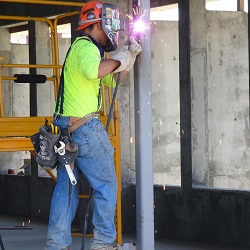WELDER
- Home
- Experts
- Other Expertise
- Welder
Appoint our skillful welder to do your work !
A Welder is responsible for designing, cutting, and permanently joining metal parts together through the application of appropriate welding techniques. The materials are fused together using high heat equipment and welding processes like MIG, TIG, and electric arc welding.
Responsibilities of a Welder
- Read blueprints and drawings and take or read measurements to plan layout and procedures
- Determine the appropriate welding equipment or method based on requirements
- Set up components for welding according to specifications (e.g. cut material with powered saws to match measurements)
- Operate angle grinders to prepare the parts that is to be welded
- Align components using calipers, rulers etc. and clamp pieces
- Weld components using manual or semi-automatic welding equipment in various positions (vertical, horizontal or overhead)
- Repair machinery and other components by welding pieces and filling gaps
- Test and inspect welded surfaces and structure to discover flaws
- Maintain equipment in a condition that does not compromise safety
Types of Welding
MIG Welding
MIG welding is one of the easiest type of welding for beginners to learn and is actually two different types of welding. The first use bare wire and the second flux core. The first step in fusion welding is to join thin pieces of metal together with bare wire MIG welding. Furthermore, we can use flux core MIG welding outside since it does not require a flow meter.. The welding of choice for DIY enthusiasts and hobby welders with limited resources is MIG welding.
Stick Welding
Stick welding also known as Shielded Metal Arc Welding is a bit harder to master than MIG welding. However, you can pick up its equipment for very little if you want to have a go at home. It uses a stick electrode welding rod.
TIG Welding
TIG welding is extremely versatile moreover it is also one of the most difficult welding techniques to learn. For TIG welding, we need two hands. One hand feeds the rod whilst the other holds a TIG torch. This torch creates the heat and arc which welds most conventional metals, including aluminum, steel, nickel alloys, copper alloys, cobalt and titanium.
Plasma Arc Welding
Plasma arc welding is a precision technique which is commonly used in aerospace applications where the metal thickness is 0.015 of an inch. One example of such an application would be on an engine blade or an air seal. Plasma arc welding is similar in technique to TIG welding, recessed are the electrodes and ionizing gases inside the arc creates heat.
- On Sale




